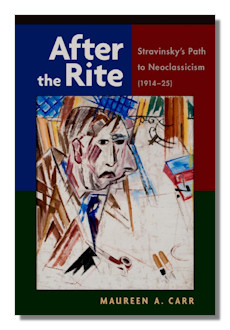
The Internet's Premier Classical Music Source
Related Links
-
Introduction
Acoustics
Ballet
Biographies
Chamber Music
Composers & Composition
Conducting
Criticism & Commentary
Discographies & CD Guides
Fiction
History
Humor
Illustrations & Photos
Instrumental
Lieder
Music Appreciation
Music Education
Music Industry
Music and the Mind
Opera
Orchestration
Reference Works
Scores
Thematic Indices
Theory & Analysis
Vocal Technique
Search Amazon
Recommended Links
Site News
 Book Review
Book Review
After the Rite

Stravinsky's Path to Neoclassicism (1914-1925)
Maureen A Carr
Oxford University Press, 2014
xxiv, 328 pp. Acid-free paper
Many musical examples, illustrations, color plates
ISBN-10: 0199742936
ISBN-13: 978-0199742936
This is hard-core musical analysis, by the author of three previous books on Stravinsky, including Multiple Masks: Neoclassicim in Stravinsky's Works on Greek Subjects; Stravinsky's Histore du soldat: A Facsimile of the Sketches; and Stravinsky's Pulcinella: A Facsimile of the Sources and Sketches. The last named received a Citation of Special Merit from the Society for Music Theory. Carr is Distinguished Professor of Music at Penn State.
The jacket copy bills this as "a treasure trove of outstanding material for scholars, musicians, students and general readers alike." Scholars and their advanced students, yes. It is emphatically not written for the general reader, who is unfortunately not going to be able to make use of her plethora of musical examples, which take up about half the book; or make much of passages like this:
Block one culminates in a series of verticalized ninths (mostly major ninths but with one minor ninth) that were so deliberately indicated in the sketch (see musical Example 3.2A). At the beginning of the second block (m. 133) one of the verticalized major ninths (D-E) from the first block is reiterated and serves as a 'hinge' between the first block and the second block. This is a wonderful example of the technique of 'cross-cutting…
No, this is a book for musicologists highly concerned with musical analysis. Given that restriction of audience, Carr provides a great deal of raw material, gleaned from her indefatigable study of source material in the Sacher archives in Basel. She includes the complete French texts of Renard and L'Histoire du soldat. She deals in depth with Stravinsky's Rossignol, Renard, Three Pieces for String Quartet, Three Easy Pieces, Histoire du soldat, Etude pour Pianola, Ragtime, Piano-Rag-Music, all written before 1920; and then Concertino, Symphonies for Wind Instruments, Pulcinella, Les cinq doigts, Mavra, Octet, Concerto for Piano and Winds, Piano Sonata and Serenade in A for Piano. Carr does have information about the critical reception of some of these works. Especially notable was a hostile audience in New York and a very cordial one in Boston, for the first performances of Concertino; and critical non-comprehension of Ragtime. In Carr's very final words she gives evidence of Stravinskian ownership of the "back to Bach" slogan, in a press conference Stravinsky gave when arriving in New York, but she does not give the date.
Carr is not concerned to argue an overall thesis, rather to show developments on a micro level. She frequently expresses agreement with the interpretations of Richard Taruskin, Edward Cone and Stephen Walsh in particular.
Recommended for those interested in advanced musical analysis.
Copyright © 2014, R. James Tobin


















